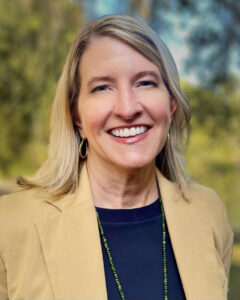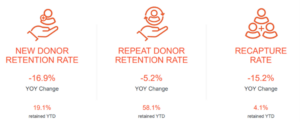 Written by Jessica Browning, principal and EVP, Winkler Group
Written by Jessica Browning, principal and EVP, Winkler Group
A sweet older couple I met gives $1,000 gifts to about ten organizations each year—nonprofits of all sizes across different sectors. These are new gifts to organizations they’ve read about in the news or have heard about for years. It’s their annual tradition, and they find joy in the spontaneous philanthropy.
I asked the couple about the response from these organizations, expecting Hallmark moments of surprise and gratitude. “We often don’t get a thank you,” the husband explained. “And when we do, it’s usually a form letter.”
I asked them what would happen if someone from one of the organizations invited them to coffee. To sit down with them, ask them about their philanthropic goals and what prompted their gift. “If that happened, would you give to the organization again the next year?” I asked.
“Of course,” they answered. “And we would probably give them a lot more.”
Sadly, they had never contemplated my question because none of the organizations have ever reached out to them.
For the past decade or so, we’ve been lamenting about the impact of mega gifts on philanthropy. They’ve drawn our attention away from what really matters, we say. They’re covering up the real issues facing fundraisers today, we explain.
It turns out that our real problem is a failure to build connection with our donors. And the rise of the mega gift isn’t the root cause. We are.
Our industry’s problem is particularly acute in the human services sector. It’s there that we see a common refrain: the organization—regardless of its size or reputation—doesn’t know its donors. I’m not talking about surface knowledge, information like whether a donor opens an organization’s enewsletter or if they’ve played in a golf tournament. Knowing your donors goes much deeper than that.
In the last year alone, we have conducted campaign feasibility studies for seven large human services organizations serving major metropolitan areas. Each organization is well-known in its community and raises at least $5 million annually from donors.
As the year went on, we noticed an alarming pattern. Each was incredibly disconnected from their donors. More often than not, these organizations didn’t have an email address or a phone number for their largest donors. It was a struggle to get donors to come in for a feasibility study interview. Participation in the electronic donor surveys was incredibly low, with several receiving fewer than 25 responses (we expect to see hundreds of completed surveys).
CAUSES OF THE DONOR IDENTITY CRISIS
The cause behind this lack of connection? Cultural factors and generational shifts likely play the biggest role, but we can point our finger in many different directions. And none of these causes should be an excuse for not cultivating generosity.
THE ROLE OF TECHNOLOGY IN THE MAJOR GIVING CRISIS
Perhaps expectantly, we look to technology. I watch my 16-year-old son hold an index card-sized screen inches from his face for hours “interacting” with his friends on Snap Chat. But when I ask him real-life questions like, “how is Will doing after his mom’s accident?” or “what does Anna want to study in college?” he draws a blank.
Real engagement is not when your donors like your Facebook post or share your Tik Tok video. That’s consumption. Engagement is when you learn something about your donors through a conversation.
FOCUS ON LOW-TOUCH FUNDRAISING
Events, annual appeals, major gift proposals, or grants don’t build relationships with donors, yet that’s where too many organizations focus their efforts. Established organizations like the one I mentioned earlier—the one that had trouble getting their donors to come in for a feasibility study interview—fall into this trap most often. They raise money off their reputation and through efforts that keep fundraisers comfortably behind their desks. Transactional fundraising doesn’t create sustainable long-term support.
GENERATIONAL DIFFERENCES
Gen X claims that millennials don’t know how to write a hand-written note. Baby Boomers complain that Gen Zers don’t know how to use a phone for live, verbal communication. Etiquette may be a lost art, but it alone isn’t to blame for the lost art of building authentic relationships. And it’s up to us, the more seasoned fundraisers, to teach these softer communication skills and demonstrate that effective donor relationship-building cannot be done by text.
MAJOR GIFT PORTFOLIO SIZE
Is a major gift portfolio with 250 donors really effective? A major gift officer with that many donors is not building meaningful relationships with their prospects. Instead, they’re relying on surface-level engagement to fill their activity quotas. Just read this account of an MGO visit gone wrong to understand the need to measure the right things—quality over quantity.
MEGA GIFTS REDUCE THE NEED FOR DONOR ENGAGEMENT
It’s not unusual for donor rates to drop in the aftermath of a large, well-publicized gift like those given by the MacKenzie Scott Foundation. The donor feels their investment isn’t needed (often the organization has done nothing to prove them wrong). And the organization—flush with revenue—loses the sense of urgency to fundraise. This is the case as well with nonprofits that depend on government funding and act more like a contract for service organization than a true nonprofit.
HOW TO MAKE DONOR ENGAGEMENT A PRIORITY
Solving the problem is relatively easy, but it takes intentionality and effort from all of us.
One of our Winkler Group clients solved their donor disengagement problem in a single year. The organization’s previous administration only knew a handful of donors—three or four billionaires who gave large gifts to the organization. There was no need to look further.
But when the nonprofit did something to upset one of those billionaires—the one who gave the most—he took his funding elsewhere. With no cultivated donors to replace him, times got tough. The executive director and most of the development department left the organization.
We began working with them just after the upheaval and we recommended that the new administration commit to eight months of intensive donor cultivation. Over those eight months, their three senior development officers each met with an average of five donors a week. Usually, these meetings were done over coffee or lunch. They were casual in nature; sometimes they would bring in a program officer or the new executive director. The development officers always made sure conversations revolved around the donor—their experiences, their interests—more than what the nonprofit had achieved.
The result of this intentional work? The organization raised $6.2 million more in 2022 than in 2021. Annual giving increased 59 percent in a single year. And 2023 giving is on track to be even higher.
WHERE TO START
It starts with identifying and qualifying mid-level and major donors; the best way to accomplish this is through a combination of wealth screening, peer review, and an assessment of past giving. Predictive donor modeling is also helpful.
Then create a personalized strategy for each of these donors. Do not treat each of them the same way. Remember, you are building authentic relationships that are special to each donor, and true cultivation should come from the heart.
When you meet with a donor in person, here are some sample questions that will lead to relationship-building conversations:
• What are your top two philanthropic passions and why?
• When did you first get involved with our organization, and what connected you to us?
• Why do you give to us? What about our work makes you proud?
• What do we do best? What could we do better?
• We are considering a program to ____. What do you think about that approach?
Done right, donor engagement involves a lot of listening. And never make a large gift request over the phone, or you will undo all your good work.
FOCUS ON DONOR RETENTION OVER ACQUISITION
In 2022, only 19 percent of new donors gave a second gift; only 58 percent repeat donors continued to give. These retention rates are atrocious, until you think back to the couple I introduced you to at the beginning of this article.
Each year, for every $100 gained from new, upgraded, or previously lapsed donors, $96 is lost from donors who stop giving. As professional fundraisers, we need to get off the hamster wheel. Developing relationships with donors is the only action that will fix this problem.
The Fundraising Effectiveness Report from Q4 of 2022 shows a decline from 2021’s already-disappointing donor retention rates.
INVOLVE ALL DEPARTMENTS—NOT JUST DEVELOPMENT
A good development director or major gift officer is also a connector who’s looking at who in the organization can add a meaningful layer to a donor relationship. Today’s donors are craving access, so allowing them to hear first-hand from a CEO, program officer, or executive director brings meaning. For example, if a donor’s passion is ending homelessness and you’ve just released a report about the connection between homelessness and affordable housing in your community, set up a meeting between the donor and the author of the report.
ADDRESS MAJOR GIFT PORTFOLIOS SIZE AND MGO TRAINING
Consider shrinking portfolios sizes so MGOs can focus on quality interactions. The average major gift officer should have a portfolio of between 100 and 150 and expect an 8 to 10 percent yield from those prospects. A VP of advancement or director of development should also maintain a portfolio of the top prospects; the size of their portfolio should be between 50 and 75. Of these prospective donors:
• 25 percent should be in the qualification phase.
• 25 percent should be in the early phases of cultivation.
• 25 percent should be in the late phase of cultivation/solicitation phase.
• 25 percent should be in the stewardship phase.
On average, it should take nine to 18 months to close a major gift. If we’re doing our jobs well, the old two-year standard becomes outdated.
THE REWARD IS WORTH THE EFFORT
As stewards of the American tradition of philanthropy, the responsibility to cultivate generosity falls to each of us. We must mentor our newer staff in the ways of effective relationship-building. We must create work environments that encourage longevity not turnover.
True major gift fundraising is intentional. It takes time, but the reward is worth the effort. Major donors are those donors who will be there in a crisis. They are your campaign’s lead donors. They are your advocates and your ambassadors. Treat them like investors, and they will be by your side through the highs and the lows.
About the Author:
Jessica Browning, principal and executive vice president of the Winkler Group, has 30 years of nonprofit experience. Her specialty is donor communications. She holds a B.A. from Duke University and an M.A. and M.B.A. from the College of William and Mary.



